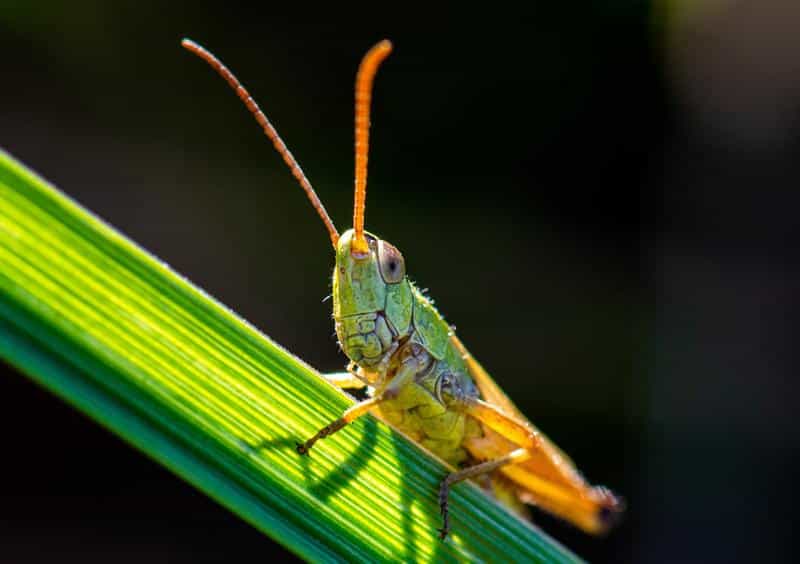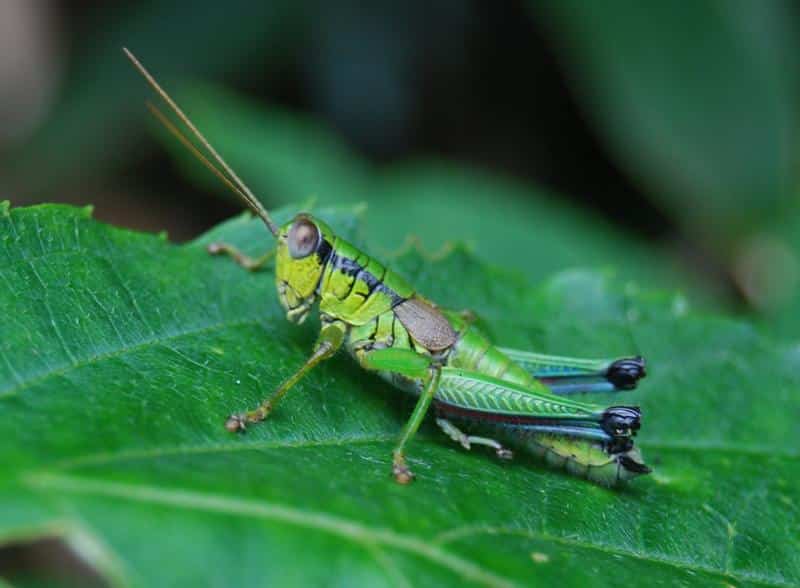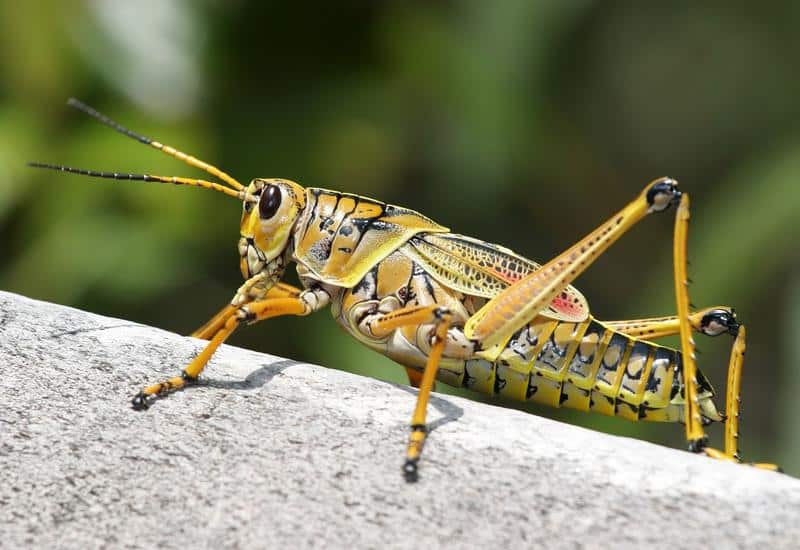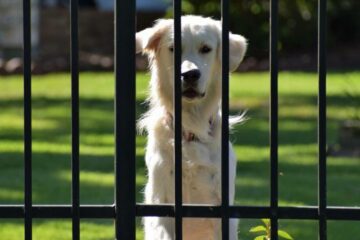Are Grasshoppers Poisonous to Dogs? Can Dogs Eat Grasshoppers?
Are grasshoppers poisonous to dogs? Can dogs eat grasshoppers? In this article, we’re going to fill you in on everything about these questions, including teaching you the simple commands to stop your dog eating grasshoppers (or any other critters) once and for all!
We’ll also get into more specific information, covering all you’ll need to know about handling your dog and the eastern lubber grasshopper. That includes are lubbers poisonous to dogs, what happens if your dog eats one, and how to get rid of lubber grasshoppers. Keep reading!
Are Grasshoppers Poisonous to Dogs?

Grasshoppers are not poisonous to dogs. Dogs may show interest in them due to their movement and may even eat them. While most dogs don’t experience serious issues after eating a grasshopper, there’s still a risk of minor gastrointestinal upset or potential internal parasites.
Are Grasshoppers Bad for Dogs?
Grasshoppers are bad for dogs. Though not inherently toxic, they can still pose certain risks. If eaten in large amounts, their hard exoskeleton could be difficult to digest, potentially leading to minor stomach upset. There’s also a risk of intestinal blockage if your dog eats a significant number of these insects, although this is relatively uncommon.
Another issue is that some grasshoppers may carry internal parasites. These parasites can infect dogs if they consume the insect, potentially leading to health issues that may require veterinary attention.
Training Your Dog: The “Stay” Command
One very effective way to prevent your dog from chasing or eating grasshoppers is to train them with the “Stay” command. Here’s how you can do it:
- Start with your dog on a leash: This gives you control and ensures your dog’s safety during training.
- Give the command: Say “Stay” in a firm, calm voice.
- Wait: If your dog stays put, praise them and offer a treat. If not, correct them and repeat the command.
- Gradually increase the distance: As your dog gets better at staying, increase the distance between you and your dog while giving the command.
Training Your Dog: The “Leave It” Command
The “Leave It” command can also be very effective. Here’s a simple way to train your dog:
- Start with a treat: Hold a treat in your closed fist and let your dog sniff it.
- Give the command: Say “Leave It” and wait for your dog to stop sniffing or licking your hand.
- Reward your dog: When your dog stops and pulls away, give them praise and offer a different treat from your other hand.
- Practice and increase the difficulty: As your dog learns, you can practice with different items and in more distracting environments.
These steps will get your dog to stop eating grasshoppers, but it’s important to remember that the underlying behavioral issues (prey drive, curiosity, overexcitement, etc.) that were causing all of this to begin with will still be present. And until you address those, any positive changes you see are only going to be temporary.
“Well, how do I make these changes last?”
By getting your dog to truly choose to follow your direction, that’s how. I tried many times to write out how you can do that before deciding it made more sense to just link you to the free video series that explains it better than I’d ever be able to.
The series is by a man named Dan who is one of the world’s leading dog obedience trainers. In it, he teaches you how to put an end to things like when your dog eats grasshoppers and all other misbehavior using his fast and easy-to-follow methods.
In the first video, Dan will reveal to you why the two most common methods of dog training only doom you to failure. You can watch the video now by clicking here. Follow the proven system he’ll show you in his series and you’ll never have to spend another second worrying about your dog eating grasshoppers ever again!
Can Dogs Eat Grasshoppers?

Dogs can eat grasshoppers without immediate danger. Still, while the insects are not poisonous, there are still potential risks involved, including minor stomach upset and exposure to parasites. You should discourage your dog from eating grasshoppers or any other insects.
My Dog Ate a Grasshopper
- Don’t Panic: If your dog ate a grasshopper, stay calm. While it’s natural to be a bit worried, grasshoppers are not toxic and won’t cause serious harm.
- Monitor Digestive Reaction: However, the insect’s hard exoskeleton can be hard to digest, potentially leading to a minor stomach upset. Monitor your dog closely for signs of distress.
- Look for Signs of Distress: Signs of distress include vomiting, lack of appetite, or changes in behavior. If such symptoms occur, consult a veterinarian.
To stop your dog eating grasshoppers or any other insects in the future, you’ll want to learn commands like “leave it” and “stay.” We explain how to do both in the first section.
Dog Eating Grasshoppers
A dog eating grasshoppers is not unusual, largely due to the insects’ quick, unpredictable movements that can stimulate a dog’s prey drive. While the occasional ingestion of a grasshopper isn’t typically harmful, it’s important to understand that regularly eating them could pose potential problems.
For instance, some grasshoppers might carry internal parasites, which could infect your dog upon being eaten. The parasites could lead to health issues ranging from mild discomfort to severe complications depending on the type and number of parasites involved.
Furthermore, grasshoppers have a hard exoskeleton which some dogs may find difficult to digest, especially if consumed in large quantities. This could lead to digestive issues over time, potentially causing discomfort, constipation or diarrhea. Therefore, while a single grasshopper might not cause harm, eating them regularly is certainly not advisable.
How to Discourage Your Dog from Eating Grasshoppers
Training your dog to avoid grasshoppers is important for their health and safety. Using commands such as “leave it” or “stay” can help. Make sure to provide positive reinforcement when your dog obeys these commands. Regularly removing grasshoppers and other insects from your yard or dog’s play area is also a good idea.
While dogs can eat grasshoppers without immediate danger, you should still not allow it due to the potential risks. Training your dog to avoid these insects (we explain how in the first section) and maintaining a clean play environment can prevent any potential health issues.
Once you get this issue taken care of, it will be very helpful as it will also make your dog safer around other insects. You then won’t have to ever worry again about things like can my dog eat a moth, can my dog eat a fly, can my dog eat a dragonfly, or can my dog eat crickets. Things like are stink bugs poisonous to dogs and are millipedes poisonous to dogs will also be of no concern.
Are Lubber Grasshoppers Poisonous to Dogs?

Lubber grasshoppers are not poisonous to dogs, but they can still cause harm. Unlike many other types of grasshoppers, lubber grasshoppers are known to produce toxins that can cause a variety of unpleasant symptoms in dogs. It is important to prevent your dog from eating these insects to avoid any health complications.
Lubber Grasshopper Poisonous to Dogs
Lubber grasshoppers, also known as Romalea guttata, are large insects native to the southeastern and south central portions of the United States. What sets these grasshoppers apart is their ability to produce toxins which they store in their bodies as a defense mechanism against predators.
The toxins aren’t lethal but can induce symptoms like foaming at the mouth, vomiting, excessive drooling, and lack of coordination in dogs if ingested. Moreover, these toxins can also cause irritations if they come into contact with your dog’s skin or eyes.
What Happens if My Dog Eats a Lubber Grasshopper?
If your dog eats a lubber grasshopper, it might experience discomfort and symptoms linked to the grasshopper’s toxins. These could include drooling, vomiting, and incoordination. In most cases, these symptoms are temporary and will dissipate on their own. However, if your dog shows severe or prolonged symptoms, you should contact a veterinarian immediately.
How to Protect Your Dog from Lubber Grasshoppers
As always, prevention is the best cure. Train your dog to avoid eating insects using the “leave it” or “stay” commands. We explain how to do these in the first section. Regularly check your yard and clear away any lubber grasshoppers to minimize the risk. If you live in an area where lubber grasshoppers are prevalent, consider discussing preventive strategies with your vet.
In conclusion, while dogs may be attracted by their sight and movement, eating lubber grasshoppers can lead to health problems due to their toxin production. Keeping your dog safe from these insects is important.
How to Get Rid of Lubber Grasshoppers
Getting rid of lubber grasshoppers can be accomplished through several methods, including encouraging natural predators, using organic methods, and employing chemical pesticides such as Sevin. Each method has its own advantages and disadvantages, so it’s important to find the one that best fits your situation and comfort level.
What Eats Lubber Grasshoppers?
In nature, lubber grasshoppers have a few predators despite their toxic defenses. Birds, such as crows, loggerhead shrikes, and cattle egrets, have adapted to tolerate their toxins. These birds can help control lubber grasshopper populations.
Some rodents and reptiles are also known to eat lubber grasshoppers. Encouraging the presence of these natural predators can assist in keeping the population in check.
How to Get Rid of Lubber Grasshoppers Organically
There are several organic ways to manage lubber grasshoppers. Handpicking and destroying eggs, nymphs, and adult grasshoppers can be effective in small gardens. Another organic option is the use of Diatomaceous earth, a non-toxic powder made from crushed fossilized algae. It can be sprinkled around plants and will kill the grasshoppers by causing dehydration.
Does Sevin Kill Lubber Grasshoppers?
Sevin, a brand of pesticide, can be effective in killing lubber grasshoppers. It contains the active ingredient carbaryl, which works by interfering with the grasshoppers’ nervous system. While it can be an effective method, it should be used carefully as it can also affect beneficial insects and may have health and environmental implications.
What Kills Lubber Grasshoppers?
Aside from Sevin, there are other commercial pesticides available that can effectively kill lubber grasshoppers. These include products containing bifenthrin or cyfluthrin. Like Sevin, these should be used with care to minimize potential negative effects on non-target insects and the environment.
The best way to get rid of lubber grasshoppers will depend on your particular situation, the size of the infestation, and your comfort level with various methods. Always consider organic and natural options first, and use chemical pesticides as a last resort.
I’m sure you’re ready to have all the headaches these grasshoppers are causing you done with, so I’ll let you get started now. Good luck with all of this, and thanks for reading our article “Are Grasshoppers Poisonous to Dogs? Can Dogs Eat Grasshoppers?”.





